13 Native Plants for Raleigh, NC
BY LYDIAN PINE | JUNE 27TH, 2019 | LAWN CARE, NORTH CAROLINA, RALEIGHElevate your Raleigh landscape with native flowers, trees, and shrubs, and invite immense benefits into your landscape. Native plants are hardy, low-maintenance, and adapted to the City of Oaks. They invite beneficial pollinators to your garden, reduce chemical use, and promote a healthier North Carolina ecosystem. Read on to discover 13 native plants for Raleigh that are sure to brighten your landscape.
In this article, we will cover:
- 13 Native Plants for Your Raleigh Yard
- How to Choose Native Plants for Your Raleigh Yard
- FAQ About Native Raleigh Plants
- Where to Find Native Plants in Raleigh
13 Native Plants for Your Raleigh Yard
1. American Beautyberry (Callicarpa americana)
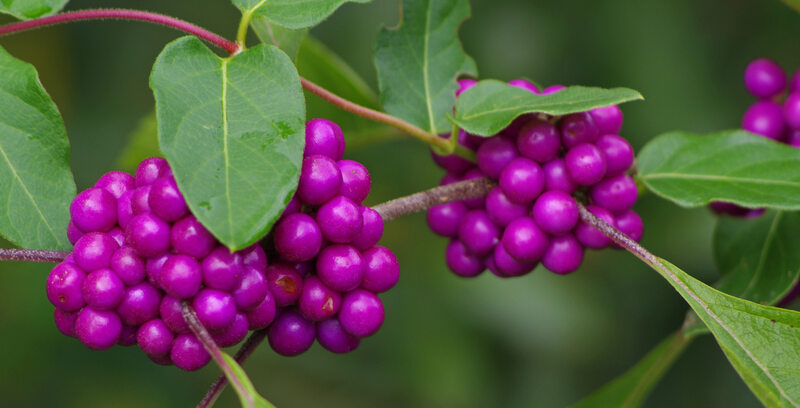
Photo Credit: Virginia State Parks staff / Wikimedia Commons / CC BY 2.0
American beautyberry produces bright purple berries that attract birds and local wildlife. During the summer, the deciduous shrub blooms pink flowers before producing its signature berries in the fall. It can grow up to eight feet tall with wide, drooping branches and saw-toothed oval leaves.
American Beautyberry is intolerant of deep shade. Find it in well-drained areas with full sun. American beautyberry thrives in all soil types and responds well to winter pruning. It is pest and disease-free and makes a great addition to beds and borders.
- Growth habit: Shrub
- USDA hardiness zone: 6-11
- Mature size: 3-6 feet tall and wide
- Duration: Perennial
- Foliage: Deciduous
- Sunlight needs: Full sun; partial shade
- Soil preferences: Adaptable; moist, well-drained chalk, clay, loam, or sand
- Water needs: Water one inch per week
- Potential hazards: Non-toxic; no safety hazards
2. Butterfly Weed (Asclepias tuberosa)
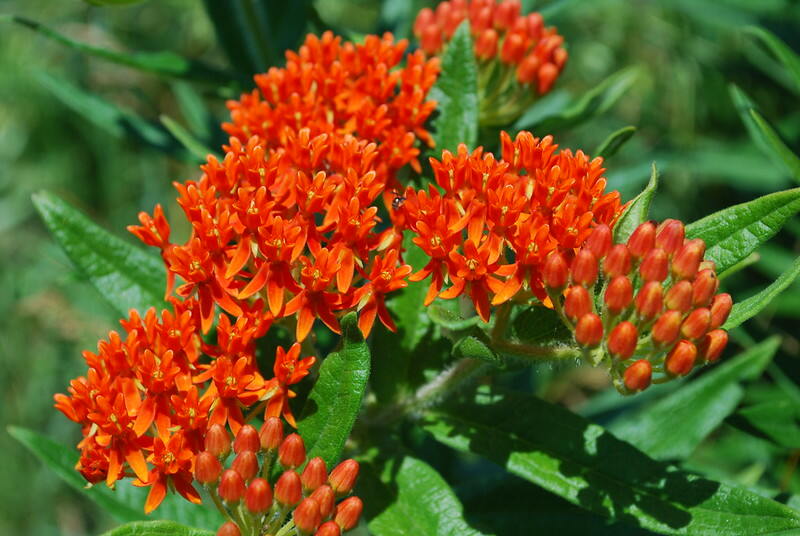
Photo Credit: Joshua Mayer / Flickr / CC BY-SA 2.0
Butterfly weed is a species of milkweed with clusters of tiny, bright orange, star-shaped flowers. It grows on straight stems with long, thin, pointed leaves. It is an important host plant for the endangered Monarch butterfly. The perennial is deer and pest-resistant and drought-tolerant, thriving in well-drained soils.
Find butterfly weed growing in prairies, along roadsides, and in open fields. Specimens propagate from seeds, taking two to three years to establish. Cut flowers make a great addition to floral arrangements. This plant is a great addition to borders, beds, and containers.
- Growth habit: Herbaceous flower
- USDA hardiness zone: 3-9
- Mature size: 1-2 feet tall and wide
- Duration: Perennial
- Sunlight needs: Full sun
- Soil preferences: Well-drained clay, loam, or sand
- Water needs: Water one inch per week when soil is dry to the touch
- Potential hazards: Toxic; poisonous if ingested in large quantities
3. Cardinal Flower (Lobelia cardinalis)
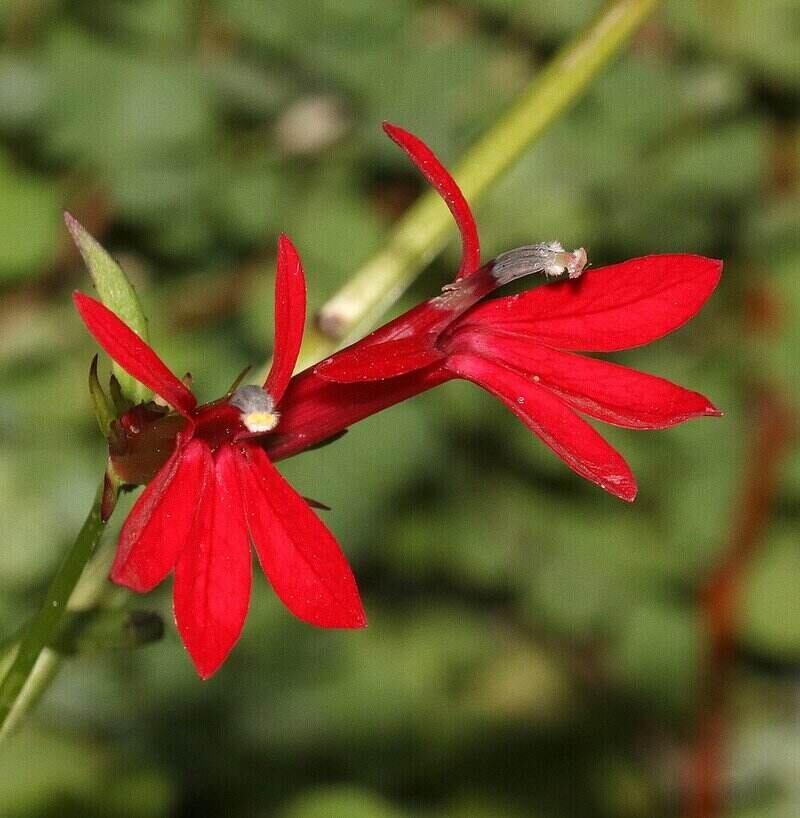
Photo Credit: ALAN SCHMIERER / Wikimedia Commons / CC0
Cardinal flower is an upright, clumping perennial with bright green leaves and showy red flowers. Each bloom has two top petals and three bottom petals united at the base of the stem.
Cardinal flower thrives in moist soil and does not tolerate drought. Specimens bloom in late summer through mid-fall, inviting pollinators like hummingbirds and butterflies. It makes a great addition to pollinator gardens, beds, and containers.
- Growth habit: Herbaceous flower
- USDA hardiness zone: 3-9
- Mature size: 3-4 feet tall and 1-2 feet wide
- Duration: Perennial
- Sunlight needs: Full sun; partial shade
- Soil preferences: Moist to wet, poorly drained, rich, medium-loam, clay-loam, limestone, sand, sand-loam, or clay
- Water needs: Maintain evenly moist soil
- Potential hazards: Toxic; poisonous if ingested in large quantities
4. Carolina Phlox (Phlox carolina)
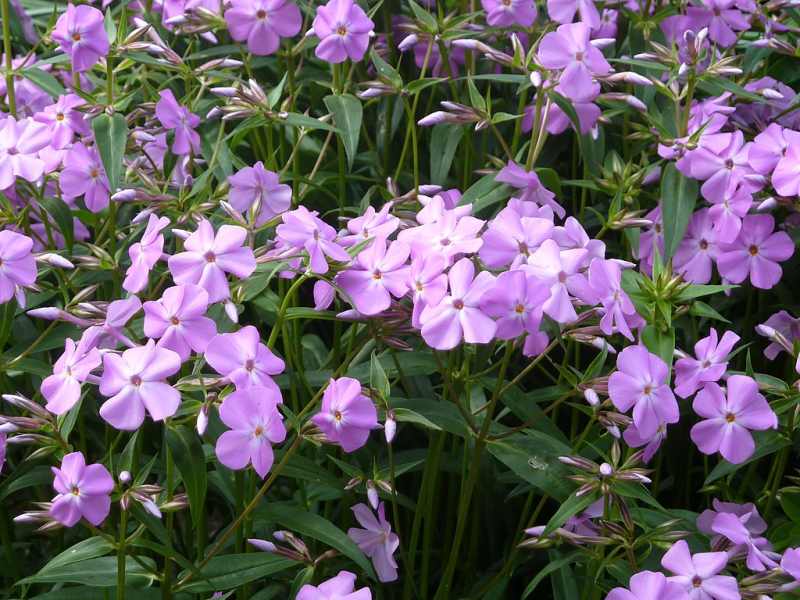
Photo Credit: peganum from Small Dole, England / Wikimedia Commons / CC BY-SA 2.0
Find Carolina phlox in woods, clearings, and along roadsides. Specimens bloom small clusters of lavender, pink, or white flowers. It has tufted stems with several pairs of narrow leaves. Plant Carolina phlox in groups as part of a border or pollinator garden.
The native perennial grows well in full sun to partial shade and thrives in rich, moist soils. It attracts hummingbirds, butterflies, and bees and self-sows without being aggressive.
- Growth habit: Herbaceous flower
- USDA hardiness zone: 5-9
- Mature size: 2-3 feet tall and 1-2 feet wide
- Duration: Perennial
- Sunlight needs: Full sun; partial shade
- Soil preferences: Moist, well-drained clay, loam, or sand
- Water needs: Drought-tolerant; water one inch per week allowing the soil to dry out between waterings
- Potential hazards: Non-toxic; no safety hazards
5. Coral Honeysuckle (Lonicera sempervirens)
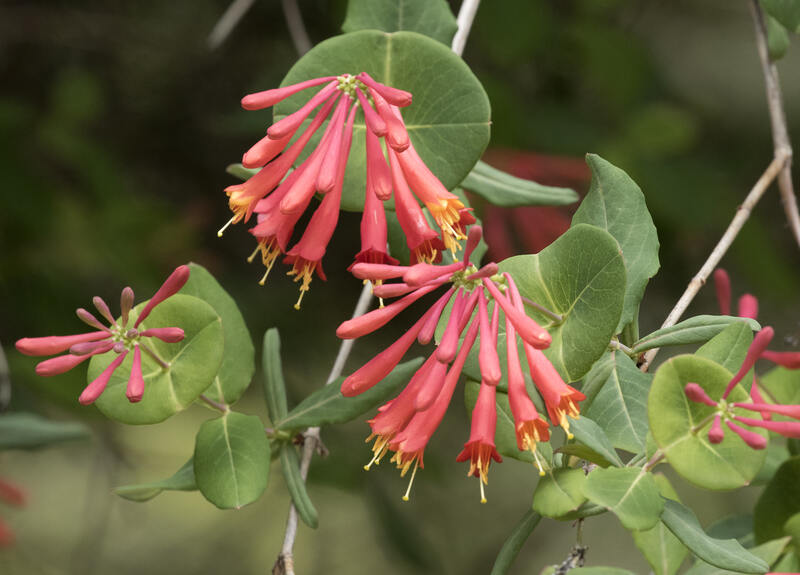
Photo Credit: Zeynel Cebeci / Wikimedia Commons / CC BY-SA 4.0
Coral honeysuckle, also known as trumpet honeysuckle, is a semi-evergreen climbing vine with whorls of red tubular flowers. Specimens climb across the ground, trees, arbors, and fences, while their blooms provide nectar for local pollinators like the Spring Azure butterfly. It has long, smooth, glossy leaves with short, blunt tips.
Coral honeysuckle prefers rich soils with good drainage. It tolerates partial shade but thrives in full sun.
- Growth habit: Vine
- USDA hardiness zone: 4-9
- Mature size: 8-15 feet tall
- Duration: Perennial
- Sunlight needs: Full sun; partial shade
- Soil preferences: Adaptable; moist, well-drained chalk, loam, clay, or sand
- Water needs: Water one inch per week, including rainfall
- Potential hazards: Toxic; poisonous berries
6. Flowering Dogwood (Cornus florida)
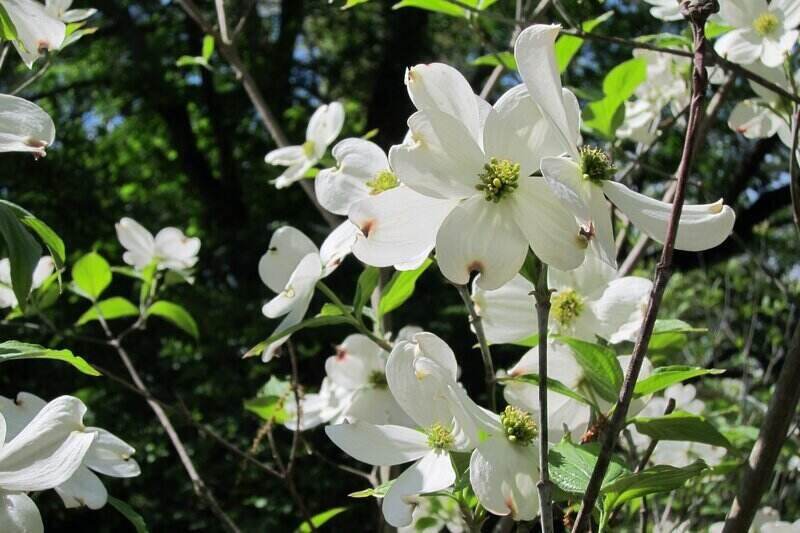
Flowering dogwood is a large shrub or small tree that produces fragrant and showy pink and white flowers. It has a flat-topped canopy, with tiered branches, and oval-shaped leaves that turn purple and scarlet during the fall. The bark is broken into small squares, giving it a scaly appearance.
Dogwood is North Carolina’s state flower and an important pollen source for local insects. Flowering dogwood prefers partial shade and moist, rich soils. Plant specimens near patios or along shrub borders.
- Growth habit: Tree
- USDA hardiness zone: 5-9
- Mature size: 20-25 feet tall and wide
- Duration: Perennial
- Foliage: Deciduous
- Sunlight needs: Full sun; partial shade
- Soil preferences: Moist, well-drained clay, loam, or sand
- Water needs: Water one inch per week
- Potential hazards: Toxic; poisonous berries
7. Foam Flower (Tiarella cordifolia)
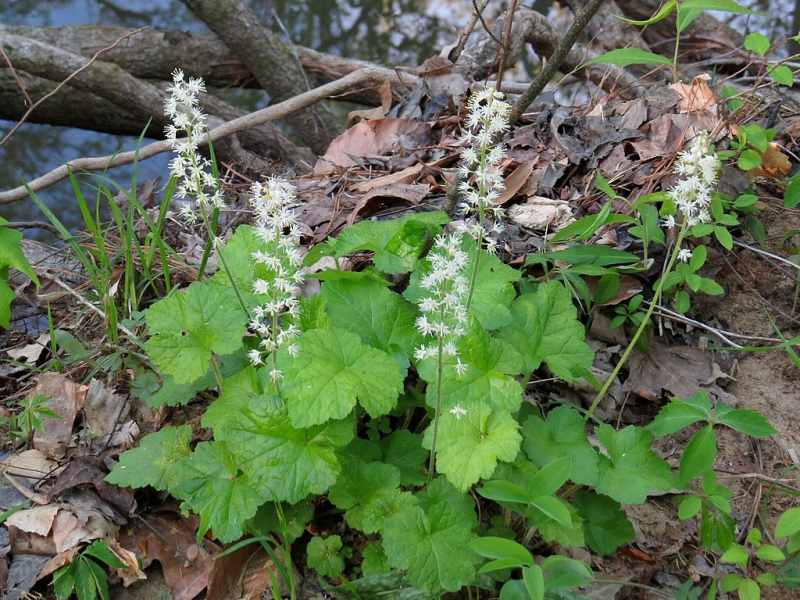
Photo Credit: Evan M. Raskin / Wikimedia Commons / CC BY 4.0
Foam flower produces tall spires of tiny, white, star-shaped flowers with a feathery appearance and glossy, heart-shaped leaves. The foliage lasts through the fall, turning shades of red and bronze. The low-growing perennial reaches up to one foot tall and makes excellent groundcover and understory additions to shady areas. Foam flower is pest and animal-resistant.
- Growth habit: Herbaceous flower
- USDA hardiness zone: 3-8
- Mature size: Up to 12 inches tall and 1-2 feet wide
- Duration: Perennial
- Sunlight needs: Partial shade; full shade
- Soil preferences: Adaptable; moist, well-drained, poorly-drained chalk, clay, or loam
- Water needs: Water one to times per week, especially during extended dry periods
- Potential hazards: Non-toxic; no safety issues
8. Frost Aster (Symphyotrichum pilosum)
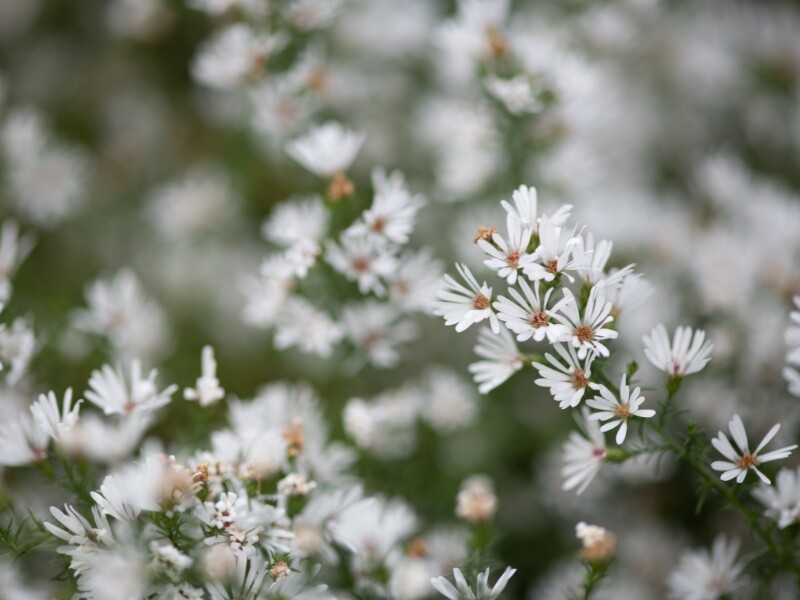
Photo Credit: marinowifi / Canva Pro / License
Frost aster, or hairy aster, is an herbaceous perennial with hairy leaves and stems. It produces small, daisy-like white flowers from summer through fall, attracting butterflies and other pollinators.
Find frost aster in prairies, meadows, and along roadsides. Specimens make great additions to butterfly, rock, and cottage gardens. Frost aster has no serious insect or disease problems but spreads aggressively.
- Growth habit: Herbaceous flower
- USDA hardiness zone: 4 -8
- Mature size: 2-4 feet tall and wide
- Duration: Perennial
- Sunlight needs: Full sun; partial shade
- Soil preferences: Adaptable; well-drained clay, loam, or sand
- Water needs: Water one inch per week
- Potential hazards: Non-toxic; no safety hazards
9. Lobed Tickseed (Coreopsis auriculata)
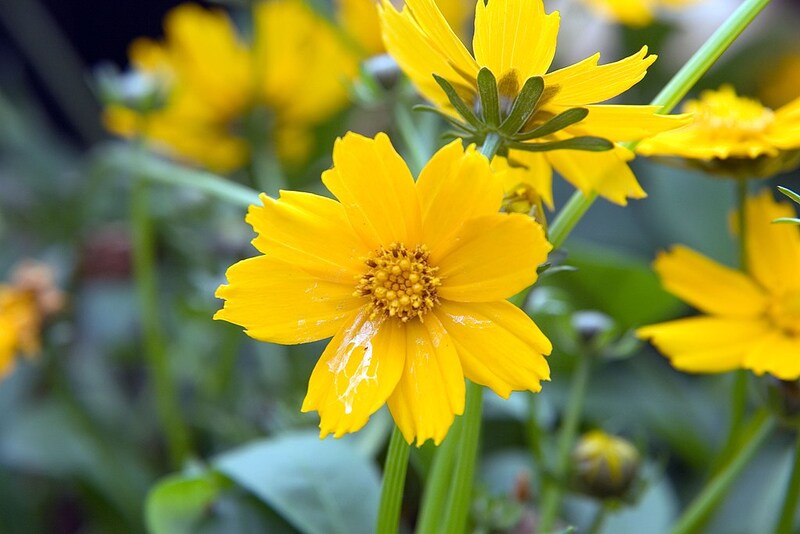
Photo Credit: David J. Stang / Wikimedia Commons / CC BY-SA 4.0
Lobed tickseed, also known as eared coreopsis, is a low-maintenance perennial with daisy-like yellow flowers. It has lobed, low-growing, dark green foliage that is evergreen. Grow these showy specimens along borders and garden edges.
Lobed tickseed spreads quickly and responds well to replanting. Lobed tickseed tolerates high humidity and is drought-tolerant and deer-resistant.
- Growth habit: Herbaceous flower
- USDA hardiness zone: 4-9
- Mature size: 1- 2 feet tall and wide
- Duration: Perennial
- Sunlight needs: Full sun
- Soil preferences: Well-drained loam or sand
- Water needs: Drought-tolerant; water one inch per week
- Potential hazards: Non-toxic; no safety hazards
10. Purple Coneflower (Echinacea purpurea)
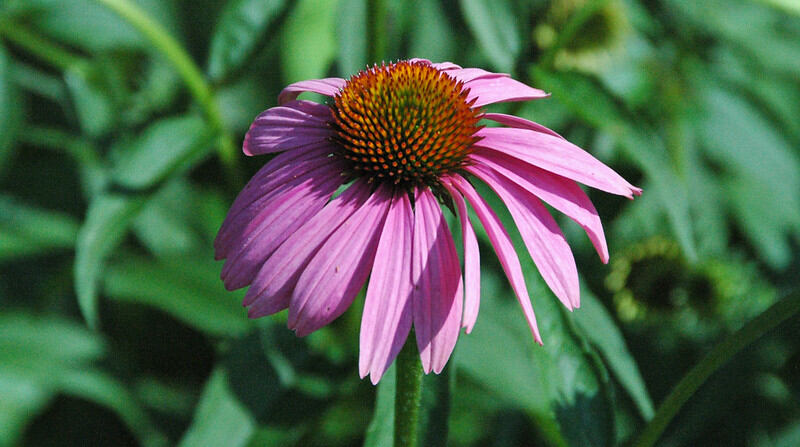
Photo Credit: James St. John / Flickr / CC BY 2.0
Find purple coneflower in prairies and meadows throughout the Oak State. The herbaceous perennial makes a great addition to rock and butterfly gardens. Purple coneflower is a vibrant wildflower that tolerates drought, humidity, heat, and poor soils and has no serious pest or disease issues.
Specimens attract hummingbirds and pollinators while their dried seeds and stalks attract small mammals and birds in the winter. The flowers resemble daisies, with drooping narrow petals around a spiny dark cone atop long, narrow stems with dark green leaves.
- Growth habit: Herbaceous flower
- USDA hardiness zone: 5-9
- Mature size: 2-3 feet tall and wide
- Duration: Perennial
- Sunlight needs: Full sun
- Soil preferences: Well-drained sand, loam, or chalk
- Water needs: Drought-tolerant; water one inch per week
- Potential hazards: Non-toxic; no safety hazards
11. Red Maple (Acer rubrum)
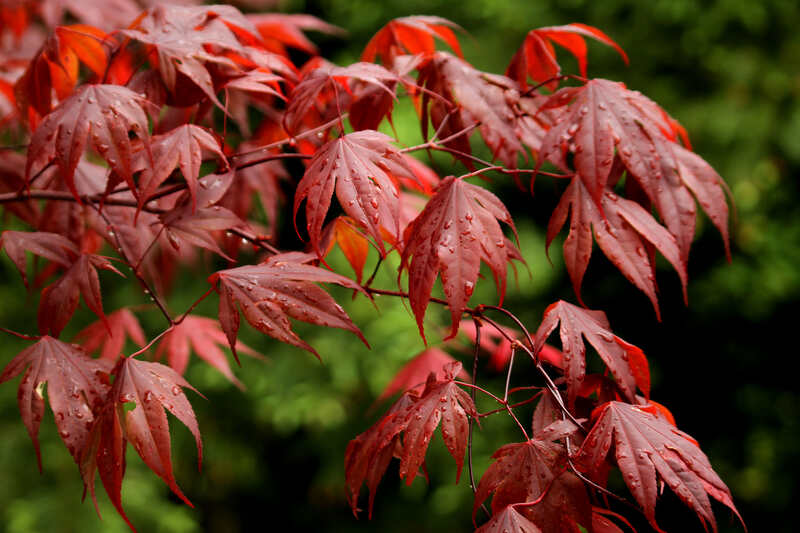
Photo Credit: Heng Wang / Wikimedia Commons / CC BY-SA 3.0
Red maple is a medium to large deciduous tree that puts on a brilliant show every fall. It is known for its red flowers, fruit, and twigs. Red maple is easy to grow and makes a great ornamental addition to any Raleigh landscape.
Specimens are adaptable and tolerate most soils and moisture conditions. Its dense roots crowd other plants growing near its base. Red maple wood is used to make flooring and furniture, while the male species produce sap for maple syrup.
- Growth habit: Tree
- USDA hardiness zone: 3-9
- Mature size: 40-70 feet tall and 30-50 feet wide
- Duration: Perennial
- Foliage: Deciduous
- Sunlight needs: Full sun; partial shade
- Soil preferences: Adaptable; moist, well-drained clay, loam, chalk, or sand
- Water needs: Water one inch per week during extended dry periods
- Potential hazards: Toxic; poisonous if ingested
12. Southern Magnolia (Magnolia grandiflora)
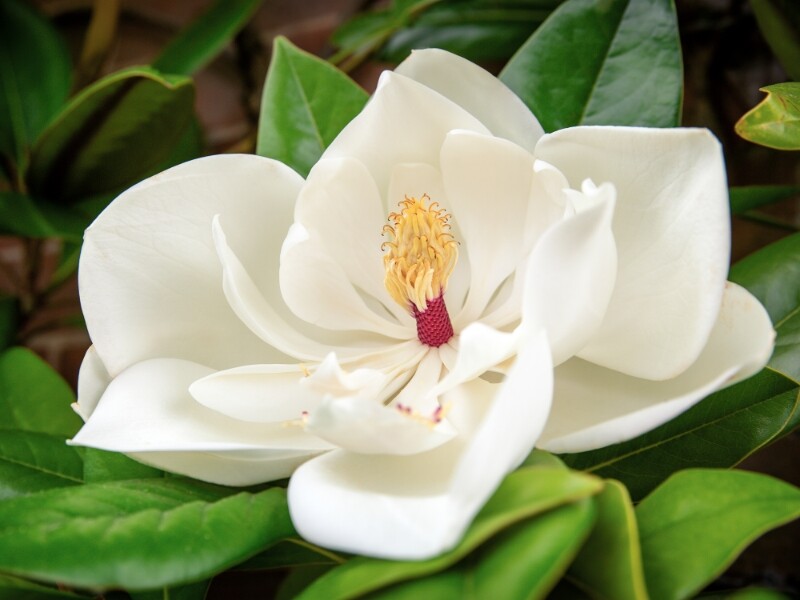
Photo Credit: Rixie / Canva Pro / License
Southern magnolia produces broad, dark green leaves and large, fragrant white flowers. It is a medium-sized tree with a spreading growth habit that makes it an ideal shade tree for Raleigh landscapes.
Southern magnolia blooms from spring until fall. The low-maintenance evergreen does not require regular pruning, and specimens produce cone-shaped fruits, attracting songbirds and small mammals.
- Growth habit: Tree
- USDA hardiness zone: 7-10
- Mature size: 60-80 feet tall and 30-50 feet wide
- Duration: Perennial
- Foliage: Evergreen
- Sunlight needs: Full sun; partial shade
- Soil preferences: Adaptable; moist, well-drained chalk, clay, loam, or sand
- Water needs: Water one to two times per week during extended dry periods
- Potential hazards: Non-toxic; no safety hazards
13. Virginia Sweetspire (Itea virginica)
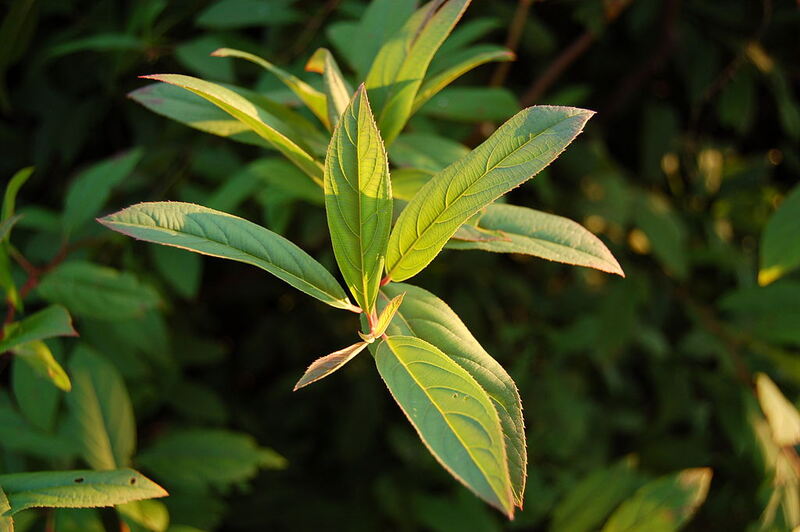
Photo Credit: (c)2006 Derek Ramsey (Ram-Man) / Wikimedia Commons / CC BY-SA 2.5
Virginia sweetspire, also known as Henry’s garnet, is a deciduous shrub with arching branches and fragrant white flowers that bloom in cylindrical tassels, providing food for pollinators. The ornamental shrub blooms in late spring through summer and grows twice as wide as it is tall.
Virginia sweetspire grows best in moist soils and prefers full sun, though specimens tolerate partial to full shade. It is deer-resistant and has no serious pest or disease problems. Specimens make a great addition to open gardens or shrub borders.
- Growth habit: Shrub
- USDA hardiness zone: 5-9
- Mature size: 3-4 feet tall and 4-6 feet wide
- Duration: Perennial
- Foliage: Deciduous
- Sunlight needs: Full sun; partial shade; shade
- Soil preferences: Moist, well-drained clay
- Water needs: Water one inch per week
- Potential hazards: Non-toxic; no safety hazards
How to Choose Native Plants for Your Raleigh Yard
Be sure to choose native Raleigh plants suited to your landscape’s soil and watering capabilities. Keep your unique USDA hardiness zone in mind. Raleigh is located in Zone 7b, meaning the coldest annual temperature ranges between 5 to 10 degrees Fahrenheit. North Carolina native plants are cold-hardy to the minimum temperature in Raleigh’s hardiness zone.
FAQ About Native Raleigh Plants
Native plants support biodiversity and a healthy Raleigh ecosystem, providing many benefits, including:
● Native plants support a diverse ecosystem, providing food and shelter for local wildlife, birds, and insects.
● They are acclimated to the subtropical climate and four distinct seasons.
● They are low-maintenance, surviving northern North Carolina weather, local insects, and disease.
Sow seeds in the early spring after the last frost.
Early morning or evening are the best times to water your native plants. Winds are calmer and temperatures are lower, so there is less risk of water loss from evaporation or scorching from the sun. Additionally, foliage needs time to dry before nightfall. Wet foliage can lead to disease and rot.
Where to Find Native Plants in Raleigh
Chances are good you already have native plants in your yard or around your neighborhood. If you want to introduce more plants into your Raleigh landscape, be sure to source your plants ethically and never transplant them from the wild.
Check out these resources in the Raleigh area:
- Field to Cottage Nursery specializing in native plants
- North Carolina’s Native Plant Society
- North Carolina State University’s list of native plants
Unfortunately, fertilizing, mowing, and watering can be time-consuming. Let Wikilawn connect you with a local lawn care pro, so you can spend more time enjoying the Old North State.
Main Photo Credit: PeteMuller / Canva Pro / License